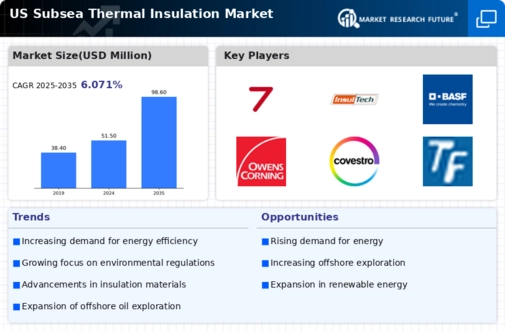The subsea thermal insulation market is characterized by a competitive landscape that is increasingly shaped by innovation, sustainability, and strategic partnerships. Key players such as BASF SE (DE), 3M Company (US), and Huntsman Corporation (US) are actively pursuing strategies that emphasize technological advancements and operational efficiencies. For instance, BASF SE (DE) has focused on enhancing its product portfolio through research and development, aiming to provide high-performance insulation solutions that meet the stringent demands of subsea applications. Meanwhile, 3M Company (US) has been leveraging its extensive expertise in materials science to develop innovative insulation products that not only improve thermal efficiency but also reduce environmental impact, thereby positioning itself as a leader in sustainable solutions. Huntsman Corporation (US) has adopted a strategy of regional expansion, targeting emerging markets to capitalize on the growing demand for subsea insulation, which collectively shapes a competitive environment that is both dynamic and multifaceted.
In terms of business tactics, companies are increasingly localizing manufacturing to enhance supply chain resilience and reduce lead times. This approach appears to be particularly effective in a moderately fragmented market where the collective influence of key players can drive innovation and efficiency. The competitive structure is characterized by a mix of established firms and emerging players, each vying for market share through differentiated offerings and strategic collaborations.
In November 2025, 3M Company (US) announced a partnership with a leading offshore engineering firm to co-develop advanced thermal insulation materials tailored for deepwater applications. This collaboration is expected to enhance 3M's product offerings and strengthen its position in the subsea market, reflecting a strategic move towards innovation-driven growth. The partnership not only aligns with 3M's sustainability goals but also underscores the importance of collaboration in addressing complex industry challenges.
In October 2025, Huntsman Corporation (US) launched a new line of eco-friendly thermal insulation products designed specifically for subsea applications. This initiative is indicative of Huntsman's commitment to sustainability and innovation, as it seeks to meet the increasing regulatory pressures and customer demand for environmentally responsible solutions. The introduction of these products is likely to enhance Huntsman's competitive edge and appeal to a broader customer base.
In September 2025, BASF SE (DE) expanded its manufacturing capabilities in the US by investing in a state-of-the-art facility dedicated to producing subsea insulation materials. This strategic investment not only aims to meet the growing demand but also positions BASF as a key player in the North American market. The facility is expected to enhance operational efficiencies and reduce production costs, thereby reinforcing BASF's competitive positioning.
As of December 2025, the competitive trends in the subsea thermal insulation market are increasingly defined by digitalization, sustainability, and the integration of advanced technologies such as AI. Strategic alliances are becoming more prevalent, as companies recognize the need to collaborate in order to innovate and respond to market demands effectively. The shift from price-based competition to a focus on innovation, technology, and supply chain reliability is evident, suggesting that future competitive differentiation will hinge on the ability to deliver high-quality, sustainable solutions that meet the evolving needs of the industry.























Leave a Comment